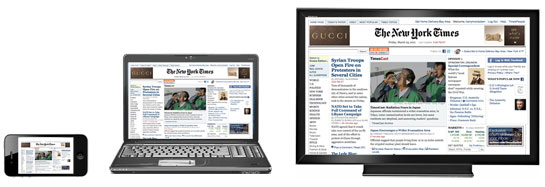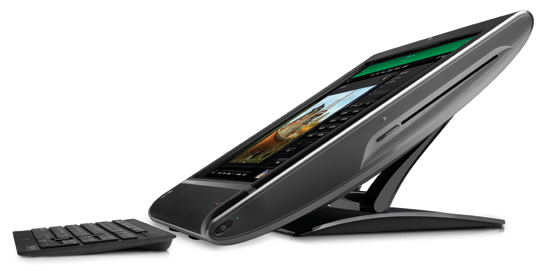 Unless you’re willfully oblivious to Moore’s Law, you know that today’s computers do a whole lot more than ones from twenty or thirty years ago, for a whole let less money. But to really judge how much more bang we get for the buck, you’ve got to adjust prices for inflation. In 2009, Benj Edwards did just that for a story we called “Classic PCs vs. New PCs: Their True Cost.” I’ll bet he was the first person to discover that a Commodore 64 and an HP Pavilion Elite cost exactly the same amount–and to compare them spec by spec.
Unless you’re willfully oblivious to Moore’s Law, you know that today’s computers do a whole lot more than ones from twenty or thirty years ago, for a whole let less money. But to really judge how much more bang we get for the buck, you’ve got to adjust prices for inflation. In 2009, Benj Edwards did just that for a story we called “Classic PCs vs. New PCs: Their True Cost.” I’ll bet he was the first person to discover that a Commodore 64 and an HP Pavilion Elite cost exactly the same amount–and to compare them spec by spec.
Tag Archives | PCs
Let Us Now Praise the Computers of the 1990s
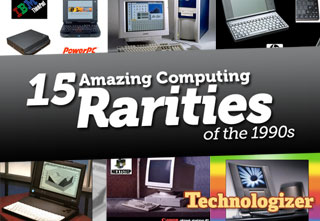 What’s the most underappreciated decade in the history of personal computers to date? Easy: The 1990s. It was a transitional period, long past the era when early giants such as the Apple II and TRS-80 ruled the world, but before things got totally commoditized. Plenty of interesting, imaginative, sometimes just plain odd computers were released during it, but few of them have gotten the glory–or at least attention–that they deserve.
What’s the most underappreciated decade in the history of personal computers to date? Easy: The 1990s. It was a transitional period, long past the era when early giants such as the Apple II and TRS-80 ruled the world, but before things got totally commoditized. Plenty of interesting, imaginative, sometimes just plain odd computers were released during it, but few of them have gotten the glory–or at least attention–that they deserve.
Computing history guru Benj Edwards, however, remembers. And he’s pulled together recollections of fifteen 1990s machines, including a PC from Sega, an Apple that wasn’t a Mac, an Atari laptop, an HP with a built-in mouse, a NeXT that didn’t come from NeXT, and more. If you’re like me, you’ll enjoy being reminded of some of them–and will learn about others for the first time.
View “15 Amazing Computing Rarities of the 1990s” slide show.
One comment
15 Amazing Computing Rarities of the 1990s
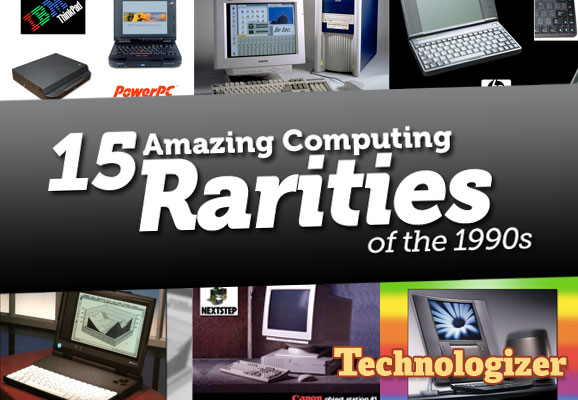 There’s a certain false assumption among computer history enthusiasts that the age of rare and interesting machines ended around the time the IBM PC-compatible platform gained almost total dominance of the PC market. As a result, you’ll see endless celebrations of vintage PCs of the 1970s and 80s. But what about the decade after that?
There’s a certain false assumption among computer history enthusiasts that the age of rare and interesting machines ended around the time the IBM PC-compatible platform gained almost total dominance of the PC market. As a result, you’ll see endless celebrations of vintage PCs of the 1970s and 80s. But what about the decade after that?
While Windows’ pervasiveness did limit computer diversity in the 1990s, it by no means stamped it out. Here are 15 amazing and unusual machines that dared to swim against the tide of conformity–albeit with limited success that leaves most of these systems extremely hard to find today. Let’s pay tribute, at long last, to these rare computers of the 1990s.
24 comments
Beige is Back: The Commodore 64 and Its Amazing Keyboard Return
 It’s back! The Commodore 64 computer you may fondly remember from your youth (assuming you were a youth back in the early 1980s) has returned from the place where old computers go to die, reborn as something that looks the same, but acts very different.
It’s back! The Commodore 64 computer you may fondly remember from your youth (assuming you were a youth back in the early 1980s) has returned from the place where old computers go to die, reborn as something that looks the same, but acts very different.
The outside is still deliciously two-tone brown, with huge clickety-clackety keys that you can type on as if typing were the only thing that could save your life, rescue fair maidens from the clutches of evil geniuses, and prevent dastardly arrays of nuclear warheads from detonating in all the great cities of the world. Yeah, that kind of typing:
The new Commodore 64 features genuine Cherry brand key switches, which provide a feel much better than the original, with a lovely IBM classic mechanism and click sound. The keys are the exact same shape as the original and are color matched. No expense has been spared. This is the ultimate hackers keyboard on which to wield your key-fu.
But inside…inside it’s a different beast. The new C64 comes with a 1.8GHz Intel processor, up to 4GB RAM, runs Windows 7, and even plays back Blu-ray discs.
9 comments
Osborne!
 Notebooks. Netbooks. Smartphones. Tablets. In 2011, the default state of personal computing is mobile–traditional desktop PCs are still with us, but they’ve become the outliers.
Notebooks. Netbooks. Smartphones. Tablets. In 2011, the default state of personal computing is mobile–traditional desktop PCs are still with us, but they’ve become the outliers.
It wasn’t always so. In their earliest days, in fact, PCs weren’t primarily deskbound; they were entirely deskbound. The notion that you might be able to carry one wherever your work took you was a radical thought.
That changed on April 3rd, 1981 when a startup called Osborne Computer Corporation announced the Osborne 1 at the West Coast Computer Faire at San Francisco’s Brooks Hall. It was the first true mass-produced portable PC and one of the most popular computers of its time. That makes this Sunday, April 3rd, 2011, as good a day to celebrate the thirtieth anniversary of portable computing as any–and to remember Adam Osborne, the company’s founder.
Today, Osborne is most famous for having failed. The conventional wisdom is that his company nosedived into bankruptcy after he announced new computers before they were ready, leading customers to stop buying the Osborne 1–a blunder that’s known as “the Osborne Effect” and which comes up to this day when tech companies announce upcoming products prematurely (or, like Apple, refuse to do so).
The conventional wisdom about Osborne Computer’s demise is wrong–more about that later on–but it is true that the company went from being described as possibly having “the steepest sales slope of any company” by analyst (and eventual Compaq chairman) Ben Rosen to bankruptcy in slightly over a year and a half. It remains one of the most sobering case studies in Silicon Valley history.
“There were three major people in the industry: Bill Gates, Steve Jobs, and Adam Osborne, and not necessarily in that order.”
–David Bunnell
But while failure is part of the Osborne story, it’s not the whole story. It’s not even the most significant part of it. For one thing, the details on Osborne Computer Company’s rise are at least as interesting as its fall. For another, Adam Osborne did a lot of stuff besides name a popular computer after himself. He founded the first significant company devoted to publishing books about microcomputers. He was a hugely influential tech pundit. And after Osborne Computer fell apart, he founded another company that also collapsed–but not before helping to pioneer the idea of really cheap software.
31 comments
Acer’s Honest Man Departs
I usually don’t write much about executive shuffles at big PC companies here (well, at least not unless they’re weird), but I’m sorry to see Acer’s CEO, Gianfranco Lanci, go. I met him on a few occasions, and he seemed to have been the rare exec who didn’t get the memo about the importance of being bland and inoffensive. (Classic example: He didn’t mince words when it came to assessing Windows Vista.)
No comments
Hey, They’re All Just Screens
I’ve been spending a lot of time lately thinking about the post-PC era. After Steve Jobs repeatedly described the iPad and other Apple products as post-PC devices at this month’s iPad 2 launch, I decided that the post-PC era is already well underway–and that it’s less about the PC going away and more about it being joined by a bevy of other gizmos, from phones to tablets to car-dashboard gadgetry. In other words, the PC is being replaced not by something but by everything. I wrote about that in this TIME.com column.
But after I finished that piece, I kept thinking about the whole subject. And I decided that the PC is, in some respects, going to be replaced by one thing, in a variety of versions.
9 comments
HPs New Slant on Touch-Screen Computing
Everyone talks about touch-screen PCs–if only to knock them–but HP, with its TouchSmarts, is one of the few companies to have devoted much thought to making touch work. Its latest TouchSmarts, announced this week, feature a small change which could have a big impact on usability: Their stands can now fold backwards, letting you use the display in traditional upright orientation or push it down to a sixty-degree angle for easier pointing that doesn’t make you stretch your arm as much. (As Cult of Mac’s John Brownlee notes, the design looks a lot like one shown in an Apple patent.) The machine is shown here with the keyboard, but I think that nudging the display down will make most sense for uses that let you move the keyboard out of the way and interact with the PC purely through touch–to browse photos, for instance, or to listen to music.
The TouchSmarts continue to run an ambitious new version of HP’s software that was introduced last fall: With an interface customized for fingers, a desktop, and a bunch of apps, it’s the touch-centric take on Windows 7 which Microsoft probably should have built itself but never has.
The TouchSmart 610 has a 23-inch display, sports Intel Core 5 and 7 processors, and starts at $899.99; HP says it’ll be available on Wednesday. A version aimed at businesses, the TouchSmart 9300 Business PC, will pack second-generation Core processors and will have an SSD option; it’ll be available in May at a price to be announced.
Am I tempted by the TouchSmarts? Nope. For one thing, I don’t think I’ll ever buy a desktop again, even an unconventional one. For another, I’m perfectly happy with a keyboard and touchpad. Still, I’m glad to see HP put effort into the idea rather than simply slapping a touchscreen on an otherwise garden-variety computer running unmodified Windows.
One comment
Ocosmos Intros Tiny Windows 7 Computer for Gaming and Work
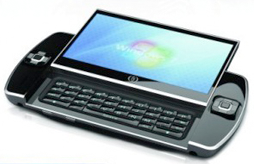
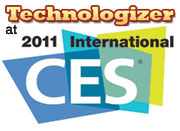 In the ever-expanding world of unconventional computers, Ocosmos has just rolled out new five- and seven-inch Windows 7-based tablets geared to folks who want to combine serious gaming for fun with their day jobs.
In the ever-expanding world of unconventional computers, Ocosmos has just rolled out new five- and seven-inch Windows 7-based tablets geared to folks who want to combine serious gaming for fun with their day jobs.
The Tiny Computer (TC) OCS1 is targeted at “heavy-duty gamers,” and the larger OCS9 tablet at “lighter gamers,” Ocosmos staffers said during the ShowStoppers press event at CES.
Despite their small sizes, both gadgets are full-featured PCs, amenable to running a built-in office suite and other work apps along with games. For gaming control, though, they also feature Ocosmos’ Omos interface.
No comments
Deceptively Thin, Surprisingly Fast
 Last Gadget Standing Nominee: Asus U36Jc-A1
Last Gadget Standing Nominee: Asus U36Jc-A1
Price: $999
 The computing world is awash in powerful laptops. There are also more and more thin-and-light notebooks with 13″ screens. But 13″ thin-and-lights that are truly powerful? They’re still a rare breed. That’s what makes the Asus U36Jc-A1 intriguing: It looks like a typical 13-incher that emphasizes portability over potency, but it packs a standard-voltage Intel Core i5 CPU and Nvidia G310M discrete graphics. It also has Nvidia’s Optimus technology, which lets the system switch between the G310M and integrated graphics on the fly for better battery life–Asus says it can run up to nine hours on a charge.
The computing world is awash in powerful laptops. There are also more and more thin-and-light notebooks with 13″ screens. But 13″ thin-and-lights that are truly powerful? They’re still a rare breed. That’s what makes the Asus U36Jc-A1 intriguing: It looks like a typical 13-incher that emphasizes portability over potency, but it packs a standard-voltage Intel Core i5 CPU and Nvidia G310M discrete graphics. It also has Nvidia’s Optimus technology, which lets the system switch between the G310M and integrated graphics on the fly for better battery life–Asus says it can run up to nine hours on a charge.
The U36Jc-A1 has an aluminum-magnesium alloy shell, is .76″ thick, and weighs 3.4 pounds. Asus says it’ll go on sale on January 17th.

